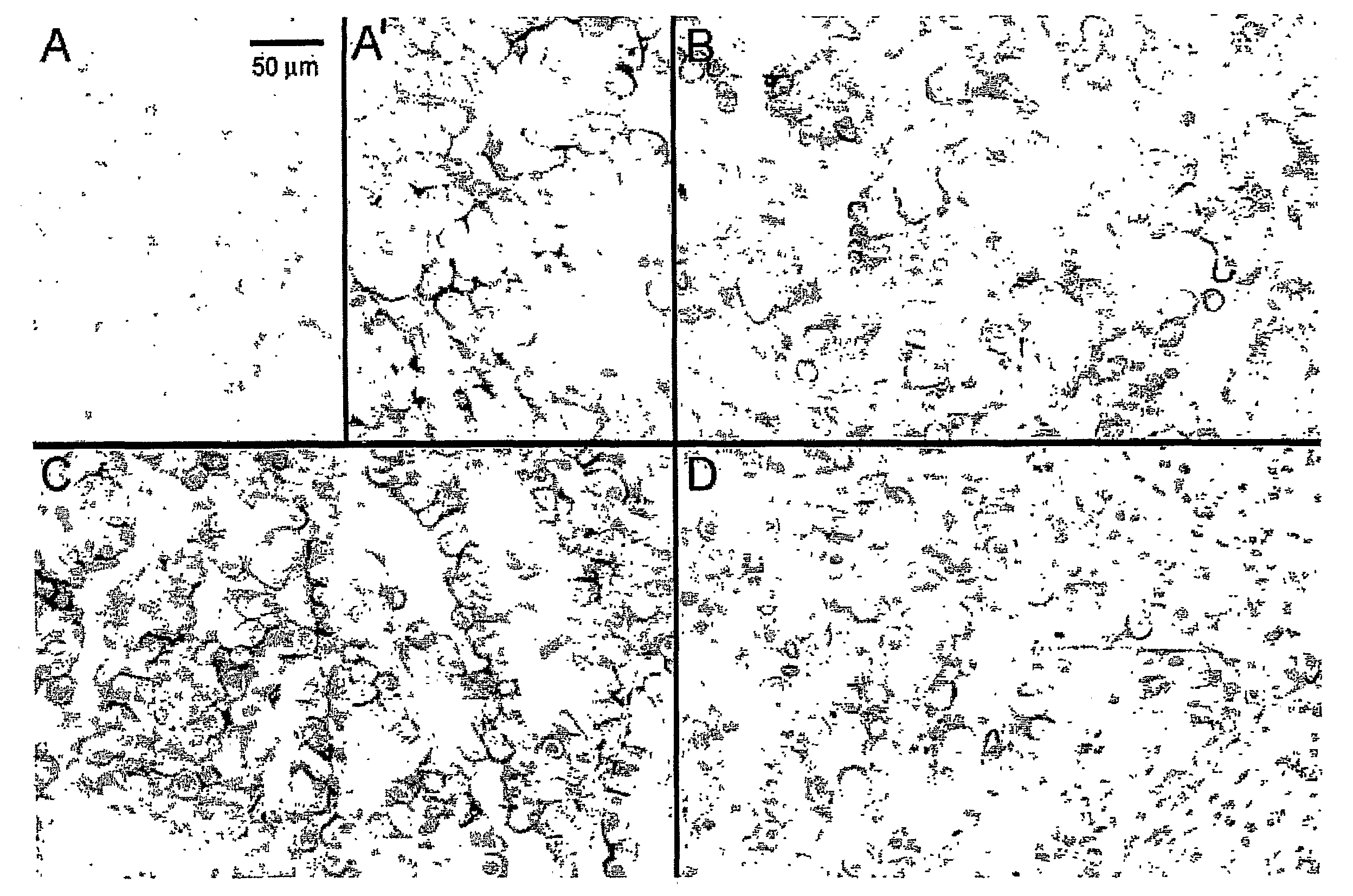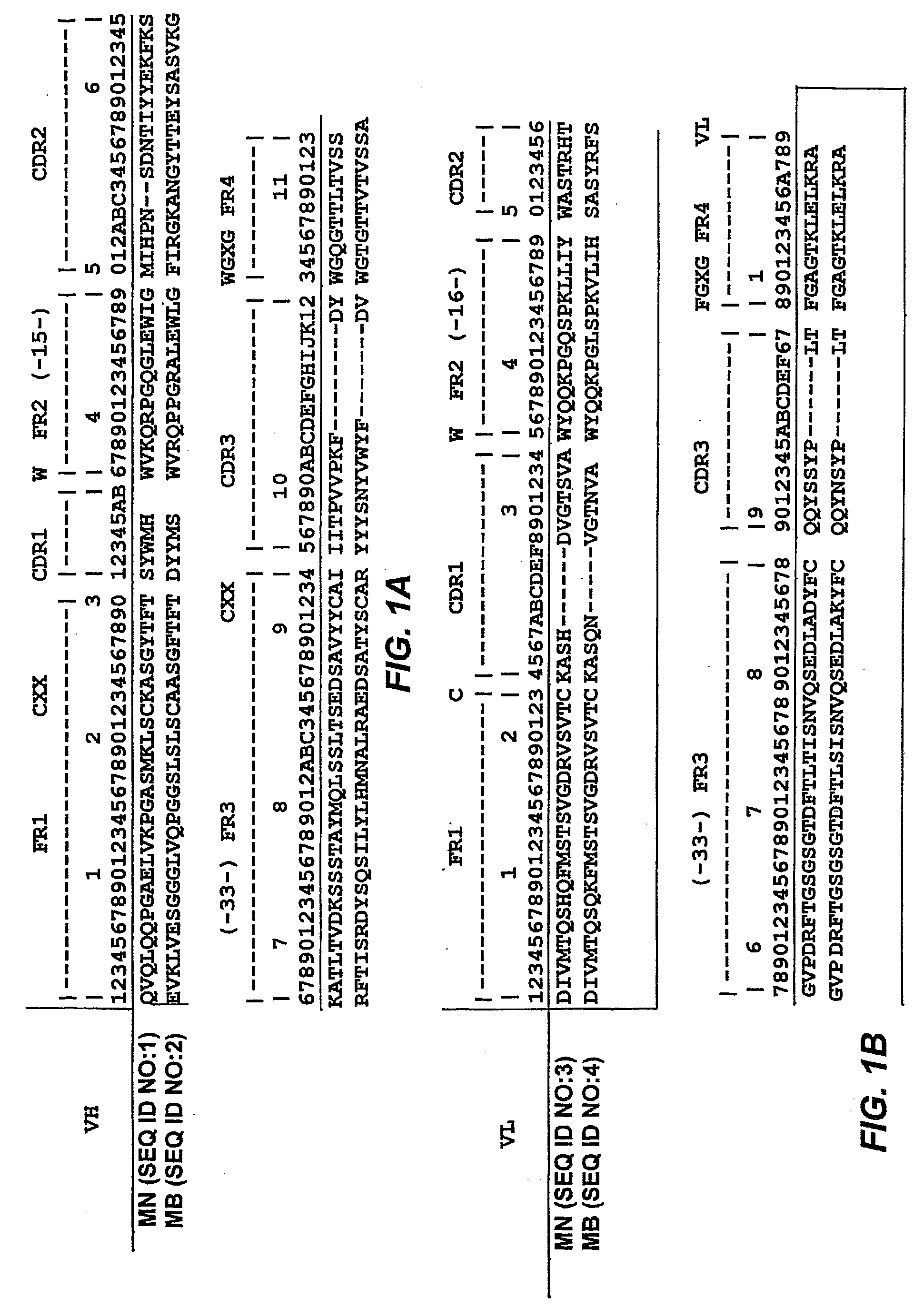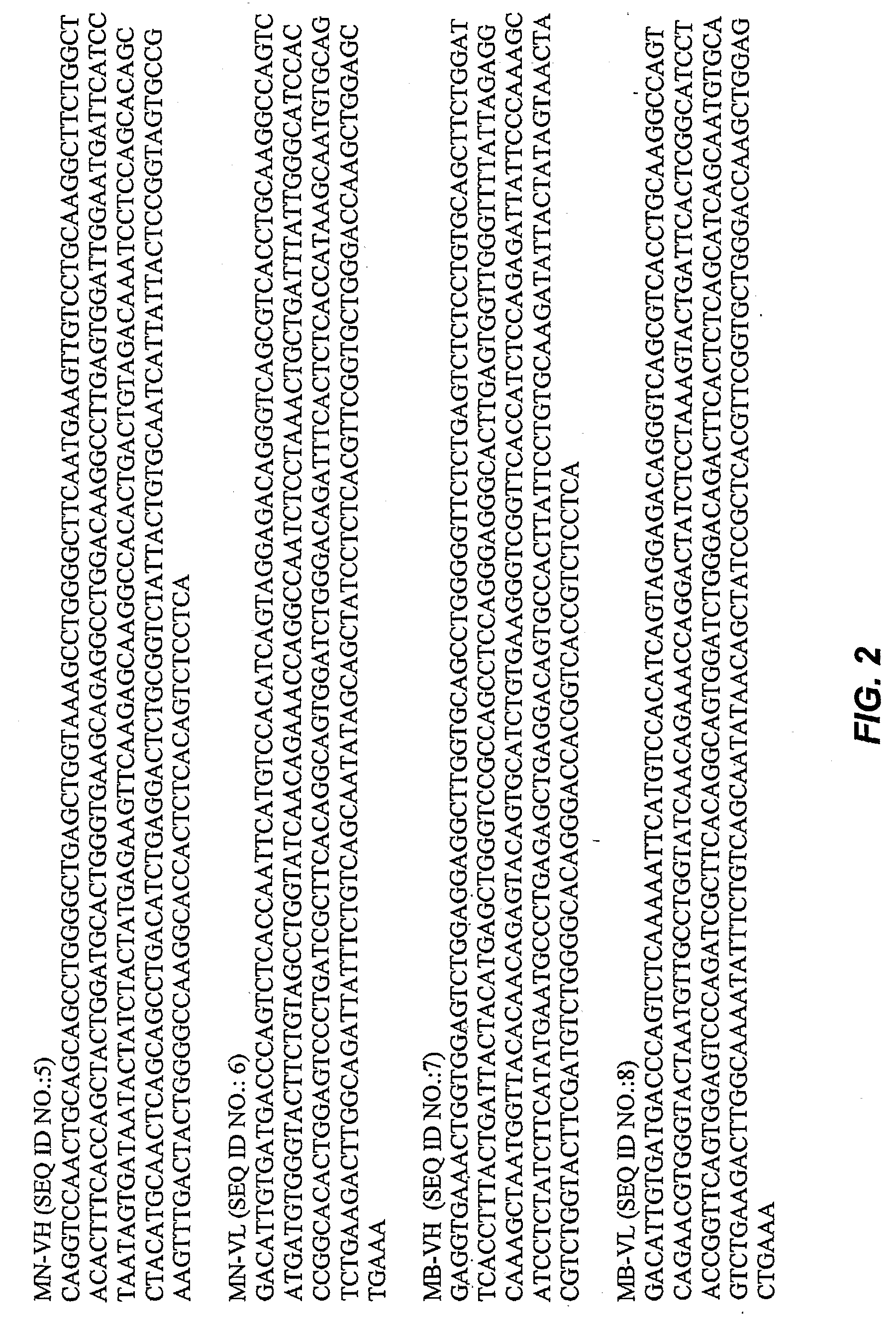[0015]In yet a further group of embodiments, the invention provides methods of inhibiting growth of a cell expressing mesothelin, which methods comprise contacting the cell with a chimeric molecule comprising (a) an antibody that binds to mesothelin, which antibody has variable heavy (VH) and variable light (VL), which VH and VL chains have 90% or greater identity to SEQ ID NOS:1 and 3, respectively, or to the VH and VL chains of antibody MB, ATCC Patent Deposit Designation PTA-6709, respectively, and (b) a therapeutic moiety, whereby contacting said cell with said therapeutic moiety inhibits growth of said cell. In some embodiments, the identity to SEQ ID NOS:1 and 3 or to the VH and VL chains, respectively, of antibody MB, ATCC Patent Deposit Designation PTA-6709, is 95% or greater. In some embodiments, the identity to SEQ ID NOS:1 and 3 or to the VH and VL chains, respectively, of antibody MB, ATCC Patent Deposit Designation PTA-6709, is 95% or greater. In some embodiments, the VH and VL chains have the sequence of SEQ ID NOS:1 and 3, respectively, or of the VH and VL chains, respectively, of antibody MB, ATCC Patent Deposit Designation PTA-6709. In some embodiments, the VH and said VL chains each have complementarity determining regions (CDRs) 1, 2, and 3, wherein (a) CDRs 1, 2, and 3 of the VH chain have the sequences shown in FIG. 1 with respect to SEQ ID NO:1 and which CDRs 1, 2, and 3 of said VL chain have the sequences shown in FIG. 1, with respect to SEQ ID NO:3, or (b) CDRs 1, 2, and 3 of said VH chain have the sequences of the CDRs of the VH chain of antibody MB, ATCC Patent Deposit Designation PTA-6709, and CDRs 1, 2, and 3 of said VL chain have the sequences of the CDRs of the VL chain of antibody MB, ATCC Patent Deposit Designation PTA-6709. In some embodiments, the VH and said VL chains each have complementarity determining regions (CDRs) 1, 2, and 3, wherein CDRs 1, 2, and 3 of said VH chain and CDRs 1, 2, and 3 of said VL chain have the sequences shown in FIG. 1 for antibody MN, or of the CDRs of the respective chain of antibody MB, ATCC Patent Deposit Designation PTA-6709, respectively, except that (i) one or more CDRs have a mutation of a residue encoded by a codon with a nucleotide falling within (A) a tetranucleotide motif A / G-G-C / T-A / T or (B) AGY, where Y can be a C or a T, or (ii) one or more CDRs have a mutation of a residue that is not encoded by a codon with a nucleotide falling within (A) a tetranucleotide motif A / G-G-C / T-A / T or (B) AGY, where Y can be a C or a T, or (iii) one or more CDRs have a mutation of a residue that is encoded by a codon with a nucleotide falling within (A) a tetranucleotide motif A / G-G-C / T-A / T or (B) AGY, where Y can be a C or a T, and one or more CDRs have a mutation of a residue that is not encoded by a codon with a nucleotide falling within (C) a tetranucleotide motif A / G-G-C / T-A / T or (D) AGY, where Y can be a C or a T. In some embodiments, the antibody is selected from the group consisting of an scFv, a dsFv, a Fab, a F(ab′)2, a diabody, a domain antibody, or an intact immunoglobulin. In some embodiments, the therapeutic moiety is selected from the group consisting of a cytotoxin, a drug, a radioisotope, or a liposome loaded with a drug or a cytotoxin. In some embodiments, the cytotoxin is selected from the group consisting of ricin A, abrin, ribotoxin, ribonuclease, saporin, calicheamycin, diphtheria toxin, a Pseudomonas exotoxin (“PE”), and botulinum toxins A through F.
[0016]In still another group of embodiments, the invention provides methods for detecting the presence of a cell expressing mesothelin in a biological sample. The methods comprise (a) contacting cells of said biological sample with a chimeric molecule comprising (i) an antibody that specifically binds to mesothelin, said antibody having a variable heavy (VH) chain and a variable light (VL) chain, which VH and VL chains have 90% or greater identity to SEQ ID NOS:1 and 3, respectively, or to the VH chain and the VL chain, respectively, of antibody MB, ATCC Patent Deposit Designation PTA-6709 SEQ ID NOS:1 and 3, and (ii) a detectable label; and, (b) detecting the presence or absence of said label, wherein detecting the presence of said label indicates the presence of a mesothelin-expressing cell in the sample. In some embodiments, the identity to SEQ ID NOS:1 and 3, respectively, or to the VH chain and of the VL chain respectively, of antibody MB, ATCC Patent Deposit Designation PTA-6709, is 95% or greater. In some embodiments, the VH chain and the VL chain have the sequence of (i) SEQ ID NOS:1 and 3, respectively, or (ii) or of the VH chain and of the VL chain, respectively, of antibody MB, ATCC Patent Deposit Designation PTA-6709. In some embodiments, the VH and the VL chains each have complementarity determining regions (CDRs) 1, 2, and 3, wherein (a) CDRs 1, 2, and 3 of the VH chain have the sequences shown in FIG. 1 with respect to SEQ ID NO:1 and which CDRs 1, 2, and 3 of said VL chain have the sequences shown in FIG. 1, with respect to SEQ ID NO:3, or (b) CDRs 1, 2, and 3 of said VH chain have the sequences of the corresponding CDRs of the VH chain of antibody MB, ATCC Patent Deposit Designation PTA-6709 and which CDRs 1, 2, and 3 of said VL chain have the sequences of the corresponding CDRs of antibody MB, ATCC Patent Deposit Designation PTA-6709. In some embodiments, the VH and the VL chains each have complementarity determining regions (CDRs) 1, 2, and 3, wherein CDRs 1, 2, and 3 of said VH chain and CDRs 1, 2, and 3 of said VL chain have the sequences shown in FIG. 1 for antibody MN, respectively, or the sequences of the corresponding CDRs of antibody MB, ATCC Patent Deposit Designation PTA-6709, respectively, except that (i) one or more CDRs have a mutation of a residue encoded by a codon with a nucleotide falling within (A) a tetranucleotide motif A / G-G-C / T-A / T or (B) AGY, where Y can be a C or a T, or (ii) one or more CDRs have a mutation of a residue that is not encoded by a codon with a nucleotide falling within (A) a tetranucleotide motif A / G-G-C / T-A / T or (B) AGY, where Y can be a C or a T, or (iii) one or more CDRs have a mutation of a residue that is encoded by a codon with a nucleotide falling within (A) a tetranucleotide motif A / G-G-C / T-A / T or (B) AGY, where Y can be a C or a T, and one or more CDRs have a mutation of a residue that is not encoded by a codon with a nucleotide falling within (C) a tetranucleotide motif A / G-G-C / T-A / T or (D) AGY, where Y can be a C or a T. In some embodiments, the antibody is selected from the group consisting of an scFv, a dsFv, a Fab, a F(ab′)2, a diabody, a domain antibody, or an intact immunoglobulin.
[0017]In another group of embodiments, the invention provides kits for detecting the presence of a mesothelin-expressing cell in a biological sample. The kits comprise (a) a container, and (b) a chimeric molecule comprising (i) an antibody that specifically binds to mesothelin, said antibody having a variable heavy (VH) chain and a variable light (VL) chain, which VH and VL chains have 90% or greater identity to SEQ ID NOS:1 and 3, respectively or to the sequences of the VH and the VL chains, respectively, of antibody MB, ATCC Patent Deposit Designation PTA-6709. In some embodiments, the identity to SEQ ID NOS:1 and 3 or to the sequences of the VH and the VL chains, respectively, of antibody MB, ATCC Patent Deposit Designation PTA-6709, is 95% or greater. In some embodiments, the antibody VH and VL chains have the sequence of SEQ ID NOS:1 and 3, respectively or the sequences of the VH and the VL chains, respectively, of antibody MB, ATCC Patent Deposit Designation PTA-6709. In some embodiments, the VH chain and the VL chain each have complementarity determining regions (CDRs) 1, 2, and 3, wherein (a) CDRs 1, 2, and 3 of said VH chain have the sequences shown in FIG. 1 with respect to SEQ ID NO:1 and which CDRs 1, 2, and 3 of said VL chain have the sequences shown in FIG. 1, with respect to SEQ ID NO:3, or (b) CDRs 1, 2, and 3 of said VH chain and which CDRs 1, 2, and 3 of said VL chain have the sequences of the corresponding chain of antibody MB, ATCC Patent Deposit Designation PTA-6709. In some embodiments, the VH and the VL chains each have complementarity determining regions (CDRs) 1, 2, and 3, wherein CDRs 1, 2, and 3 of the VH chain and CDRs 1, 2, and 3 of the VL chain have the sequences shown in FIG. 1 for antibody MN or CDRs 1, 2, and 3 of the corresponding chain of antibody MB, ATCC Patent Deposit Designation PTA-6709, for antibody MB, respectively, except that (i) one or more CDRs have a mutation of a residue encoded by a codon with a nucleotide falling within (A) a tetranucleotide motif A / G-G-C / T-A / T or (B) AGY, where Y can be a C or a T, or (ii) one or more CDRs have a mutation of a residue that is not encoded by a codon with a nucleotide falling within (A) a tetranucleotide motif A / G-G-C / T-A / T or (B) AGY, where Y can be a C or a T, or (iii) one or more CDRs have a mutation of a residue that is encoded by a codon with a nucleotide falling within (A) a tetranucleotide motif A / G-G-C / T-A / T or (B) AGY, where Y can be a C or a T, and one or more CDRs have a mutation of a residue that is not encoded by a codon with a nucleotide falling within (C) a tetranucleotide motif A / G-G-C / T-A / T or (D) AGY, where Y can be a C or a T. In some embodiments, the kit further comprising a detectable label.
 Login to View More
Login to View More 


